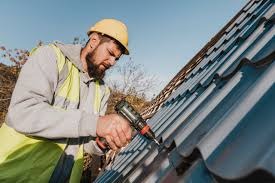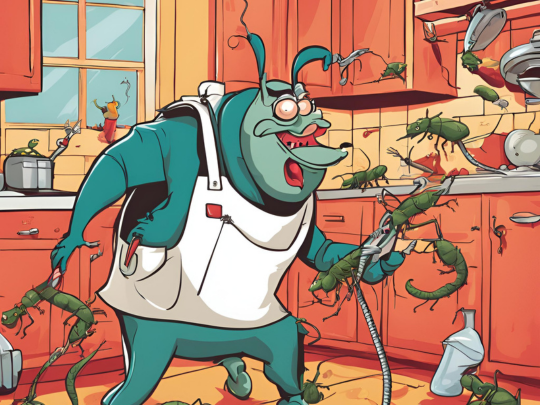As a homeowner, you might not think much about your roof until a problem arises. However, being aware of common roof repairs can save you from costly surprises down the line. From identifying leaks to replacing damaged shingles, understanding these essential maintenance tasks can keep your home safe and sound. You may even be surprised at how straightforward some of these repairs can be. So, what are the key issues you should be looking out for, and how can you tackle them effectively?

Identifying Roof Leaks
Identifying roof leaks is crucial for maintaining the integrity of your home. To start effective leak detection, examine your roof for visible signs of damage, such as cracked or missing shingles, which can lead to moisture intrusion.
A thorough moisture assessment involves checking the interior for water stains or mold, indicating potential leak sources. During rainstorms, closely monitor your ceilings and walls for any signs of dripping or dampness.
You can also use a moisture meter to measure humidity levels in various areas, ensuring no hidden leaks are present. If you suspect a leak but can’t locate it, consider hiring a professional who specializes in leak detection to conduct a comprehensive inspection and provide targeted solutions.
Replacing Damaged Shingles
Replacing damaged shingles is a straightforward process that can significantly enhance your roof’s durability and appearance.
First, identify the type of shingle materials—such as asphalt, wood, or metal—you’re working with. Gather necessary tools, including a pry bar, roofing nails, and a utility knife.
Start by carefully lifting the damaged shingles with the pry bar. Remove any nails and discard the old shingles.
Next, cut a new shingle to fit, ensuring it matches the existing materials. Use appropriate installation techniques by aligning the new shingle with surrounding ones and nailing it down securely.
Lastly, seal the edges with roofing cement to prevent water infiltration.
Regularly inspecting and replacing damaged shingles can prolong your roof’s lifespan and maintain its integrity.
Repairing Roof Flashing
After addressing damaged shingles, it’s important to consider the roof flashing, as it plays a vital role in preventing leaks.
Flashing materials, such as aluminum or copper, need to be inspected regularly for wear. Common issues include rust, cracking, or improper installation techniques, which can compromise your roof’s integrity.
You should repair flashing at least once every few years, especially after severe weather. For DIY approaches, ensure you use appropriate sealing methods, like roofing caulk, to secure gaps.
However, complex flashing types may require professional services for proper installation and long-term durability.
Always consider weather conditions when planning repairs, as moisture can affect adhesion and effectiveness.
Regular maintenance tips can help extend the lifespan of your flashing and prevent costly repairs.
Clearing Clogged Gutters
Gutters act as essential channels for directing rainwater away from your roof and foundation, but they can easily become clogged with debris like leaves, twigs, and dirt.
Regular gutter maintenance is crucial for ensuring effective water drainage and protecting your home from potential damage.
Here are three steps you should follow when clearing clogged gutters:
- Inspect: Check for visible debris and assess the overall condition of your gutters.
- Clear: Use a ladder to safely remove clogs with a scoop or your hands, wearing gloves for protection.
- Flush: Run water through the gutters to confirm that they’re flowing freely.
Addressing Ponding Water
Ponding water on your roof can lead to significant structural issues if not addressed promptly. This stagnant water often results from improper drainage, inadequate slope, or blockages in your roofing system.
Understanding the ponding water causes is crucial for effective maintenance. To mitigate these risks, start by inspecting your roof for any visible dips or debris. Regularly clearing gutters and downspouts is essential to prevent blockages.
For long-term ponding water solutions, consider installing additional drainage systems or modifying the slope of the roof. You might also want to explore roofing materials that minimize water accumulation.
Addressing ponding water proactively will extend your roof’s lifespan and safeguard your home’s structural integrity. Don’t wait—take action to ensure your roof remains healthy.
Fixing Ventilation Issues
Proper ventilation is crucial for maintaining your roof’s integrity and preventing moisture buildup.
You might notice signs like excessive heat, mold growth, or condensation, indicating ventilation problems.
Addressing these issues promptly can involve solutions such as installing vents or fans to enhance airflow.
Importance of Proper Ventilation
Ensuring adequate ventilation in your roof system is crucial for maintaining its integrity and longevity.
Proper ventilation systems promote effective air circulation, which helps regulate temperature and moisture levels. Without this, you risk severe damage to your roof and home.
Consider the following benefits of proper ventilation:
- Prevents heat buildup: Reduces the risk of shingle damage and extends roof lifespan.
- Reduces moisture accumulation: Minimizes the chances of mold and mildew growth, protecting your indoor air quality.
- Enhances energy efficiency: Keeps your home cooler in summer and warmer in winter, lowering energy costs.
Signs of Ventilation Problems
When it comes to roof ventilation, spotting signs of issues early can save you from costly repairs down the line. One of the first indicators of ventilation problems is poor air circulation. If you notice that your attic feels stuffy or hot, it may signal that air isn’t flowing properly.
Additionally, excessive humidity is another red flag; if you see condensation on windows or mold growth, your ventilation system may not be functioning effectively. Check for damp insulation or a musty odor, which can also signify trapped moisture.
Lastly, look for curled or buckled shingles, as they may indicate overheating due to inadequate ventilation. Addressing these signs promptly can help maintain your roof’s integrity and prolong its lifespan.
Solutions for Ventilation Issues
Addressing ventilation issues effectively can significantly enhance your roof’s performance and longevity. Proper airflow management is crucial to prevent moisture buildup and maintain temperature balance within your attic.
Here are some solutions to improve your ventilation systems:
- Install ridge vents: These allow hot air to escape from the roof’s peak, promoting better circulation.
- Add soffit vents: Positioned under the eaves, they ensure fresh air enters, working in tandem with ridge vents.
- Use powered attic ventilators: These can actively expel hot air, especially in warmer climates, ensuring optimal conditions.
Dealing With Ice Dams
Ice dams can cause significant damage to your roof and interior if left unaddressed.
Understanding the causes of ice dams, along with effective prevention strategies and repair techniques, is essential for maintaining the integrity of your home.
In this section, you’ll learn how to identify and manage these winter challenges effectively.
Causes of Ice Dams
Understanding the causes of ice dams is crucial for effective prevention and repair. Ice dams typically form when heat loss from your home warms the roof surface, causing snow accumulation to melt. As the melted water flows down, it refreezes at the colder eaves, creating a dam of ice.
Here are the primary causes:
- Poor insulation: Inadequate insulation allows heat to escape, increasing roof temperatures.
- Ventilation issues: Insufficient ventilation traps warm air in the attic, contributing to heat loss.
- Snow accumulation: Excessive snow on the roof exacerbates melting, leading to more ice formation.
Identifying these factors can help you address the underlying issues before they lead to significant damage.
Prevention Strategies
To effectively prevent ice dams and their associated damage, you need to focus on both proper insulation and adequate ventilation in your home.
Regular inspections of your roof and attic can help identify areas needing insulation upgrades or moisture barriers. Ensure you’re conducting seasonal maintenance to check for roof coatings that can enhance weatherproofing.
Trim any tree overhangs to minimize debris and facilitate proper drainage. Additionally, using weatherproof materials for your roofing can provide extra protection against ice buildup.
Installing vents can promote air circulation, further preventing heat buildup that leads to ice dams.
Repair Techniques
Dealing with ice dams requires prompt and effective repair techniques to prevent further damage to your roof and home.
To tackle this issue efficiently, consider these strategies:
- Inspect flashing techniques: Ensure your roof flashing is secure and watertight, as gaps can lead to leaks when ice melts.
- Perform shingle repairs: Check for damaged or missing shingles that could exacerbate water infiltration. Replace any compromised shingles to maintain a protective barrier.
- Clear gutters and downspouts: Ensure there’s no blockage to facilitate proper drainage, which helps reduce ice dam formation.
Maintaining Roof Seals
Maintaining roof seals is crucial for ensuring your roofing system remains watertight and effective. To achieve this, you need to choose the right sealant types, such as silicone, polyurethane, or asphalt-based options, each suited for different conditions and surfaces.
Before application, clean the area thoroughly to remove dirt, debris, and old sealant. Utilize proper application techniques, like using a caulking gun for precise lines and ensuring even coverage.
Pay special attention to seams, joints, and flashing, as these areas are prone to leaks. Regularly inspect your seals for signs of wear or damage, and reapply sealant as needed to prevent moisture infiltration.
Proper maintenance can significantly extend the lifespan of your roofing system.
Inspecting for Mold Growth
When inspecting your roof, look for signs of mold presence, such as dark spots or a musty odor.
Identifying these indicators early can help you implement effective prevention and maintenance strategies.
Regular checks will ensure your roof remains in good condition and free from mold-related issues.
Signs of Mold Presence
Identifying signs of mold presence is crucial for maintaining the integrity of your roof and home.
Mold types, such as black mold, can pose significant health risks, including respiratory issues and allergic reactions.
To effectively inspect for mold growth, look for the following indicators:
- Discoloration: Dark spots or patches on your roof or walls may signify mold presence.
- Musty Odors: A persistent, damp smell often indicates mold lurking in hidden areas.
- Water Damage: Leaks or water stains can create an environment conducive to mold growth.
Regularly checking these signs helps you tackle potential mold issues early, ensuring a safer living space and preventing costly repairs down the line.
Stay vigilant to protect your health and property.
Prevention and Maintenance Tips
To effectively prevent mold growth on your roof, regular inspections are essential. Conduct seasonal inspections to assess your roof’s condition and identify any signs of moisture accumulation.
Prioritize roof maintenance by incorporating preventative care practices, such as surface cleaning to remove debris and organic materials that foster mold. Implement weatherproofing techniques to enhance material durability and protect against water intrusion.
Ensure your roof’s structural integrity by checking for damaged shingles or leaks that can create mold-friendly environments. By addressing these issues promptly, you’ll significantly extend your roof’s longevity and maintain its performance.
Understanding Roof Inspections
A thorough roof inspection is essential for maintaining the integrity of your home. Regular inspections help identify potential issues before they escalate, safeguarding your investment.
Utilizing a roof inspection checklist ensures you cover all critical aspects, including:
- Shingle condition: Assess for cracks, curling, or missing shingles.
- Flashing integrity: Check for rust or gaps around chimneys and vents.
- Gutter and drainage: Ensure proper water flow to prevent pooling.
While DIY inspections are useful, opting for professional inspection benefits you by providing expert insight and advanced tools to detect hidden problems.
A skilled inspector can spot issues that may not be visible, giving you peace of mind and helping to extend your roof’s lifespan.
Why You Choose Pure Energy Roofing Company
Based in Brighton, MI, and serving the greater Southeast Michigan area, Pure Energy Roofing Company is a family-owned and operated business known for exceptional roofing services. Led by Adrian Beavers and Matt Masters, the company specializes in roof replacement, storm damage repairs, gutter replacements, and attic insulation. Their status as an Owens Corning Certified Contractor ensures every project is completed with top-quality materials and expert craftsmanship. With a commitment to dependable service and a personalized approach, Pure Energy Roofing has become a trusted partner for homeowners.
Conclusion
You might think roof repairs are too daunting or costly, but addressing issues early can save you significant money in the long run. By staying proactive with inspections and maintenance, you can tackle common problems like leaks and damaged shingles before they escalate. Remember, a well-maintained roof not only protects your home but also boosts its value. Don’t wait for a minor issue to become a major headache—take charge of your roof’s health today.

